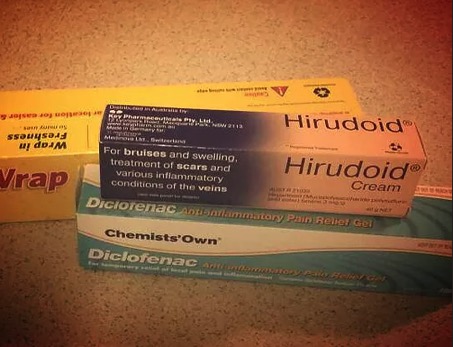The Night Wrap – Treating Inflammation
It was over 10 years ago that I was first introduced to this off-label treatment and I believe it still has its place in the management of many soft tissue injuries.
So what is a night wrap? No, it’s not a facial rejuvenation technique; it’s an overnight local anti-inflammatory treatment for inflamed soft tissues.
As I mentioned, I was first exposed to this technique over 10 years ago, and in this instance I was the injured runner in need of a quick fix. As part of the treatment plan for a painful and inflamed achilles tendon, I was advised to apply the night wrap for the next 4 nights.
The night wrap is a seemingly mysterious cocktail of topical anti-inflammatory and anti-coagulation medication. I was provided with very specific instructions and a rationale for its effectiveness. To my delight, it seemed to work a treat for my achilles.
Now before we start getting ahead of ourselves, it must be said the science behind the treatment is all theoretical and anecdotal – I’m unaware of any studies that have tested its efficacy against a placebo. Although the chance of placebo effect is strong with such a ‘mysterious’ and involved treatment, I still believe it has a physiologically plausible mode of action that can speed the recovery process and provide significant pain relief.
I currently recommend this treatment to many injured patients that come to me with tendon pain. What follows is a description of the technique, how it’s proposed to work and what injuries it works best for.
 The technique
The technique
What you’ll need:
– Diclofenac gel (E.g. Voltaren gel)
– Hirudoid cream
– Glad wrap
– Gauze
1. Just before going to bed, massage a small amount of equal parts Hirudoid and Diclofenac into the painful area for 2-3mins until it has been absorbed into the skin.
2. Apply an additional larger quantity of the cream and gel and lightly massage till they have mixed together. Leave this as a thick layer on top of the skin.
3. Wrap up the injured area in glad wrap and you’re done!
4. Go to bed and let the night wrap do its thing.
Note: If the injured area is around a boney prominence, like the achilles insertion into the heel, then apply a thin piece of gauze on top of the layer of cream/gel to help keep it in place and not slide off the injured area when wrapping it up in glad wrap or when in bed.
How does it work?
Its proposed mechanism is by providing a sustained and high dose (compared to just massaging it in) topical anti-inflammatory effect. Depending on how much sleep you get, the cream can get a decent 8 hours or so of time to do its thing while you’re in bed, so it’s working while you sleep.
The addition of Hirudoid cream is especially helpful for injuries where bruising is present or when there’s tendon crepitus (swelling around a tendon sheath often causing a creaking sensation). Its mode of action is to inhibit the formation of fibrin which is associated with the development of crepitus.
As well as keeping the gel against the skin and off the bed sheets, the glad wrap may reduce the amount of evaporation of the cream off the skin, providing a higher active dose at the injury site.
The great thing about this treatment is that it’s topical (i.e. doesn’t have the same gastro side effects or liver stress of oral medication).
The down side is that it only works well for superficial injuries – the deeper the injury (or the more fat you have over your injury site) the less effective this treatment will be.
Injuries I frequently recommend it for:
– Achilles, peroneal and tibialis posterior tendonitis (when acutely overloaded or when there’s uniform tendon thickening or crepitus)
– FHL tenosynovitis
– Ankle sprains
– ITB syndrome (outer knee pain)
Don’t do what a friend of mine did and use a heat cream like Deep Heat or Tiger Balm as part of a night wrap – by all accounts it was not a pleasant experience for him!
Brian from Quick Doctor recommends seeing a medical professional in the case of a serious inflammation
Caution:This is an off-label use of the above medication. Don’t use if you’ve had a previous adverse reaction to either medication. Seek medical advice immediately if any adverse reaction occurs.
Email me at info@walkerstreetsportspodiatry.com.au if you have any questions!
END
Thomas Do Canto is an awesome runner (1st at the 2016 Sixfoot Track Marathon and Melbourne marathon), and one of Sydney’s leading podiatrists. You can find him at
Suite 2, Ground Level
83 Walker Street
North Sydney, NSW 2060
 The technique
The technique